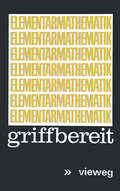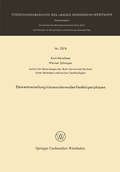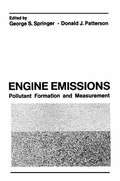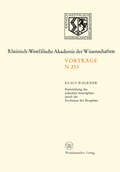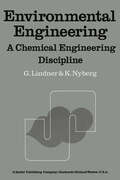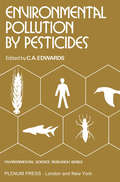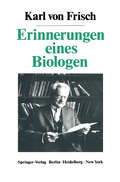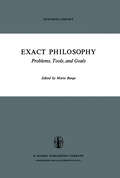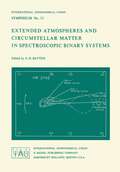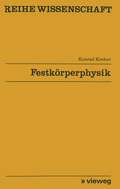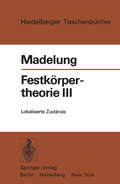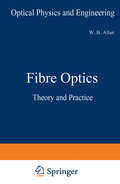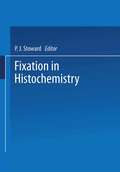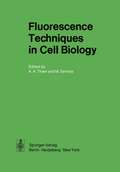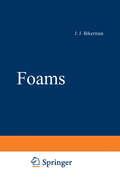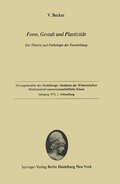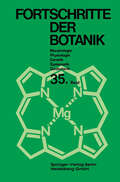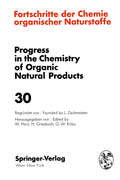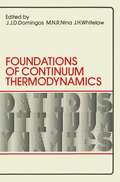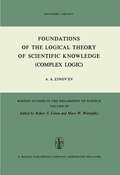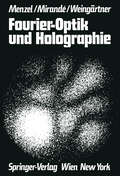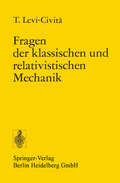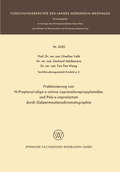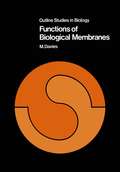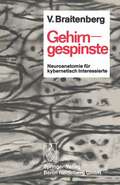- Table View
- List View
Elementverteilung in koexistierenden Festkörperphasen: (pdf) (Forschungsberichte des Landes Nordrhein-Westfalen #2374)
by Kurt AbrahamEngine Emissions: Pollutant Formation and Measurement
by George S. Springer and Donald J. PattersonIn recent years, emissions from transportation engines have been studied widely because of the contribution of such engines to atmospheric pollution. During this period the amounts of pollutants emitted, the mechanism of their formation, and means of controlling emissions have been investigated in industrial and government laboratories, as well as at universities. The results of these investigations have generally been published as individual articles in journals, transactions, meeting proceedings, and, frequently, in company reports. This proliferation of technical information makes it difficult for workers in the field to keep abreast of all developments. For this reason, the editors felt the need for a book which would survey the existing state of knowledge in wide, albeit selected areas, and would provide a guide to the relevant literature. This book is intended to fulfill this function. It is recognized that all aspects of transportation engine emissions cannot be explored in a single volume. In this book attention is focused primarily on sources and mechanisms of emission formation within the combustion process, and on measurement techniques. Beyond this objective, no re strictions were placed on the authors. Within the framework of the general theme each author has been free to treat his subject as he saw fit. The editors have not strived to replace by uniformity the highly personal and attractive divergences of style. Considerable efforts were made, however, to ensure clarity and minimum overlap between the chapters.
Entwicklung der irdischen Atmosphäre durch die Evolution der Biosphäre (Rheinisch-Westfälische Akademie der Wissenschaften #233)
by Klaus WagenerEnvironmental Engineering: A Chemical Engineering Discipline
by G. Lindner K. NybergChemistry and its products today play an important role in almost all industrial ac tivities. Chemistry has captured our homes. We are supplied with new articles in an ever-increasing stream. New uses are being discovered. Old products disappear. Continuing and fast expansion is expected for the chemical industry in its proper sense. The reason for this is, of course, that chemistry has created products which meet requirements that we consider urgent or which in different ways make work easier, and make us more efficient, thereby increasing our standard of living in a wide sense: in terms of money, more spare time, social security, better education and better public health services. But a high standard of living also implies a good living environment. A lot of what has been done in praiseworthy aspiration of a better means of support and an im proved standard of living has involved a wasting of non-renewable natural resources. The products themselves or their waste products may pose a threat to the objectives we are trying to attain.
Environmental Pollution by Pesticides (Environmental Science Research #3)
by C. EdwardsThe persistent organic pesticides have saved millions of lives by controlling human disease vectors and by greatly increasing the yields of agricultural crops. However, in recent years man has become ever more conscious of the way in which his environment is becoming increasingly polluted by chemicals that may harm plants, animals or even himself. Amongst these chemicals the organochlorine insecticides have been well to the fore as a major cause of anxiety to ecologists, not only because they persist so long, but also because of the readiness with which they are taken up into the bodies of living organisms, especially the fatty tissues of both animals and humans. The extent and seriousness of the potential hazards due to these chemicals still remains to be fully defined. Our information on the occur rence of residues in the various parts of the environment is very uneven and localized. For instance, whereas we have a great deal of data on residues in North America, we know virtually nothing about the extent of pesticide contamination in Africa, South America and much of Asia, although large amounts of organochlorine insecticides have been used in these areas.
Exact Philosophy: Problems, Tools, and Goals (Synthese Library #50)
by Donald DavidsonThe papers that follow were read and discussed at the first Symposium on Exact Philosophy. This conference was held at Montreal on November 4th and 5th, 1971, to celebrate the sesquicentennial of McGill University and establish the Society for Exact Philosophy. The expression 'exact philosophy' is taken to signify mathematical phi losophy, i.e., philosophy done with the explicit help of mathematical logic and mathematics. So far the expression denotes an attitude rather than a fully blown discipline: it intends to convey the intention to try and pro ceed in as exact a manner as we can in formulating and discussing phi losophical problems and theories. The kind of philosophy we wish to practice and promote is disciplined rather than wild, systematic rather than disconnected, and capable of being argued over rather than oracular. We believe that even metaphysics, notoriously riotous, can be subjected to the control of logic and mathematics. Even the history of philosophy, notoriously unsystematic, can benefit from an exact reconstruction of some classical ideas.
Extended Atmospheres and Circumstellar Matter in Spectroscopic Binary Systems (International Astronomical Union Symposia #51)
by A. H. BattenThe proposal to organize a Symposium on circumstellar matter and extended atmo spheres in binary systems was first made by the Dominion Astrophysical Observatory to the Executive Committee of the International Astronomical Union in the summer of 1969. It received the support of the presidents of Commissions 29 (Stellar Spectra), 30 (Radial Velocities), 36 (Stellar Atmospheres), and 42 (Photometric Double Stars). Approval in principle was given by the Executive Committee almost immediately, and the Committee further suggested that the Symposium be officially designated the Struve Memorial Symposium. Final approval was given at the time of the 1970 General Assembly of the Union. when the dates of the Symposium were set for August or September, 1972. The Organizing Committee set up consisted of K. O. Wright (Chairman), A. H. Batten, K. -H. B6hm, A. A. Boyarchuk, G. Larsson-Leander, and M. Plavec. In addition, J. Sahade and F. B. Wood acted as advisory members. Local organization was entrusted to a committee consisting of A. H. Batten, E. K. Lee, and C. D. Scarfe. The final dates selected were September 6-12, 1972, and the Sym posium was held at the Island Hall Hotel, Parksville, B. C. , on Vancouver Island some 90 miles from Victoria. The Organizing Committee attempted to arrange a Symposium of the type in which no contributed papers would be presented and discussion would range as widely as possible over the field covered by the six invited review papers.
Fibre Optics: Theory and Practice (Optical Physics and Engineering)
by W. B. AllanThe emergence of fibre optics as a commercially viable technology oc curred barely ten years ago; in this time it has become an established field with a variety of applications. This book has been written in an attempt to review the entire field with an emphasis on the practical applications of the technology. This approach has been adopted since it was felt that there was a need for a work which could be referred to by non -specialists in the field who were interested in, or who wished to make use of, fibre optics. With this readership in mind, the theory has been presented in as simple a manner as possible and emphasis has been placed on the description of typical applications and the manufacturing techniques of the technology. It is hoped that this mode of presentation will en able the reader to form an appreciation of both its advantages and its limitations.
Fixation in Histochemistry
by P. J. Stowardby by Professor Professor A. A. G. G. Everson Pearse Pearse The tide of of the Symposium, at at which the the papers which compromise this volume were presented, is ofthe utmost importance. It was not 'Fixation and Tissue Destruction' or 'Fixation 'Fixation and and Loss Loss ofTissue Components', Components', but but 'Fixation and and Tissue Tissue Preservation'. Historical Historical fixatives, fixatives, some some still still with with us us in the field oflight oflight microscopy microscopy after after over over 100 100 years, are are not not less less guilty guilty than than the the new new historical 'fixatives' of of ultrastructural ultrastructural practice practice some some ofwhich of which remove up up to to 60% 60% ofthe of the material material originally present in in the specimen and and convert the remainder into chemically inert products. There There must must be be few few histochemists histochemists who who do not not appreciate appreciate the great need need for for improve improve ments ments in in the the practice practice of of fixation, fixation, but but whence whence can can we we hopefully hopefully expect expect the arrival arrival of such such improvements? improvements ? Apart Apart from from out out ofthe ofthe blue, or revolutionary, revolutionary, advances advances such such as as the advent advent of of glutaralde hyde, there are perhaps three principal sources.
Fluorescence Techniques in Cell Biology
by Andreas A. Thaer Manfred Sernetz.For there to be progress in science, there must first be communication between experts of different disciplines. This is particularly true of modern biology which is becoming more and more of an interdisciplinary field. The present situation in cell biology clearly reflects this devel opment and demonstrates that the application of physical techniques was necessary before this field of biological research could be developed on an objective and quantitative basis. The utilization of optical phenomena as measuring parameters at the microscopic level has provided the basis for the development of quantitative cytochemistry. This rapidly growing extension of conventional cytochemistry and histochemistry is based on the visual oberservation of qualitative chemical criteria in correlation with the microscopically resolved structure of cells and tissues. Furthermore, the introduction into cytochemistry of such optical measuring techniques as ab sorption photometry, interferometry, and fluorometry, as well as the measurement of optical anisotropy, diffrac:tion and scattered light, has provided the methodological bridge for the ex change of knowledge between cell biology on the one hand and biochemistry, or molecular biology, on the other.
Foams (Applied Physics and Engineering #10)
by J.J. BikermanThe book Foams: Theory and Industrial Applications, written by the undersigned and three collaborators and published in 1953, is still the only monograph on liquid foam in the English language. Naturally the science of foams had advanced in the intervening years so that a practically new book had to be prepared to give justice to the present state of our know ledge. This monograph has only one author and does not deal with solid foams, fire-fighting foams, and flotation, on which information is available elsewhere. The other applications of foam and its fundamental properties are reviewed at length and, whenever possible, attempts are made to reach the truth through a maze of conflicting evidence. February 1973 J. J. BIKERMAN Contents page Preface . v 1. General. Foam Films (Sections 1-22) 1 Foam Films 5 References 30 2. Formation and Structure (Sections 23-42) 33 Dispersion Methods 33 Condensation Methods 51 Foam Structure 59 References 62 3. Measurement of Foaminess (Sections 43-62) 65 Films and Bubbles 66 Foams. 76 References 94 4. Results of Foaminess Measurements (Sections 63-84) . 98 Poorly Foaming Liquids . 98 Strongly Foaming Liquids 108 Other Systems 132 References 140 5. Three-phase Foams (Sections 85-90) 149 References 157 6. Foam Drainage (Sections 91-106) 159 Experimental Data . 173 References 181 7. Mechanical Properties of Foams (Sections 107-122) 184 References 211 8. Optical Properties of Foams (Sections 123 -127) . 214 References 222 vii viii Contents 9.
Form, Gestalt und Plastizität: Zur Theorie und Pathologie der Formbildung (Sitzungsberichte der Heidelberger Akademie der Wissenschaften #1973 / 1)
by Volker BeckerFortschritte der Botanik (Progress in Botany #35)
by Heinz Ellenberg Karl Esser Hermann Merxmüller Eberhard Schnepf Hubert ZieglerFortschritte der Chemie Organischer Naturstoffe / Progress in the Chemistry of Organic Natural Products (Fortschritte der Chemie organischer Naturstoffe Progress in the Chemistry of Organic Natural Products #30)
by M. J. Cormier H. Flasch B. Franck K. Hori L. Jaenicke W. Keller-Schierlein H. D. Locksley D. G. Müller J. Polonsky R. Tschesche J. E. Wampler G. WulffFoundations of the Logical Theory of Scientific Knowledge (Boston Studies in the Philosophy and History of Science #9)
by A.A. Zinov'evBoston Studies in the Philosophy of Science are devoted to symposia, con gresses, colloquia, monographs and collected papers on the philosophical foundations of the sciences. It is now our pleasure to include A. A. Zi nov'ev's treatise on complex logic among these volumes. Zinov'ev is one of the most creative of modern Soviet logicians, and at the same time an innovative worker on the methodological foundations of science. More over, Zinov'ev, although still a developing scholar, has exerted a sub stantial and stimulating influence upon his colleagues and students in Moscow and within other philosophical and logical circles of the Soviet Union. Hence it may be helpful, in bringing this present work to an English-reading audience, to review briefly some contemporary Soviet investigations into scientific methodology. During the 1950's, a vigorous new research program in logic was under taken, and the initial published work -characteristic of most Soviet pub lications in the logic and methodology of the sciences - was a collection of essays, Logical Investigations (Moscow, 1959). Among the authors, in addition to Zinov'ev himself, were the philosophers A. Kol'man and P. V. Tavanec, and the mathematicians and linguists, S. A. Janovskaja, A. S. Esenin-Vol'pin, S. K. Saumjan, G. N. Povarov.
Fragen der Klassischen und Relativistischen Mechanik: Vier Vorträge Gehalten in Spanien im Januar 1921
by Tullio Levi-CivitaFraktionierung von N-Propionyl-oligo-ε-aminocapronsäurepropylamiden und Poly-ε-caprolactam durch Gelpermeationschromatographie (Forschungsberichte des Landes Nordrhein-Westfalen)
by Giselher ValkGehirngespinste: Neuroanatomie für kybernetisch Interessierte
by Valentin BraitenbergIch glaube, daß das interessanteste Forschungsobjekt dieser Welt, abgesehen von der Welt selbst, das menschliche Gehirn ist. So wie eines Tages die Einsicht in das Wesen der Materie gewaltige Verände rungen in unserem Denken zur Folge haben wird, ähnlich erschütternd wird, glaube ich, das volle Verständnis der Weise sein, wie das Ge hirn als ein Teil der Natur uns auch die Kenntnis der Natur vermittelt. Ich kann mir auch denken, daß die Erklärung der Materie erst auf die Erklärung des Gehirns zu warten hat, um mit ihr zusammen das ge schlossene Bild der Welt zu ergeben, das die Philosophen suchen. Der Zweck dieses Buches ist, gemessen an den weitschweifenden Gedanken, bescheiden. Es besteht aus lose zusammenhängenden Kapiteln, alle offen, keines endgültig, insgesamt weit entfernt von dem Anspruch, ein Lehrbuch der Gehirnwissenschaften abzugeben. Es sollte verstanden werden als eine kurze Einladung in die Welt unserer Laboratorien, mit einer Schau unserer hübschesten For schungsobjekte und mit Diskussionen, die nicht unbedingt über zeugen, sondern eher eine Atmosphäre vermitteln wollen.
